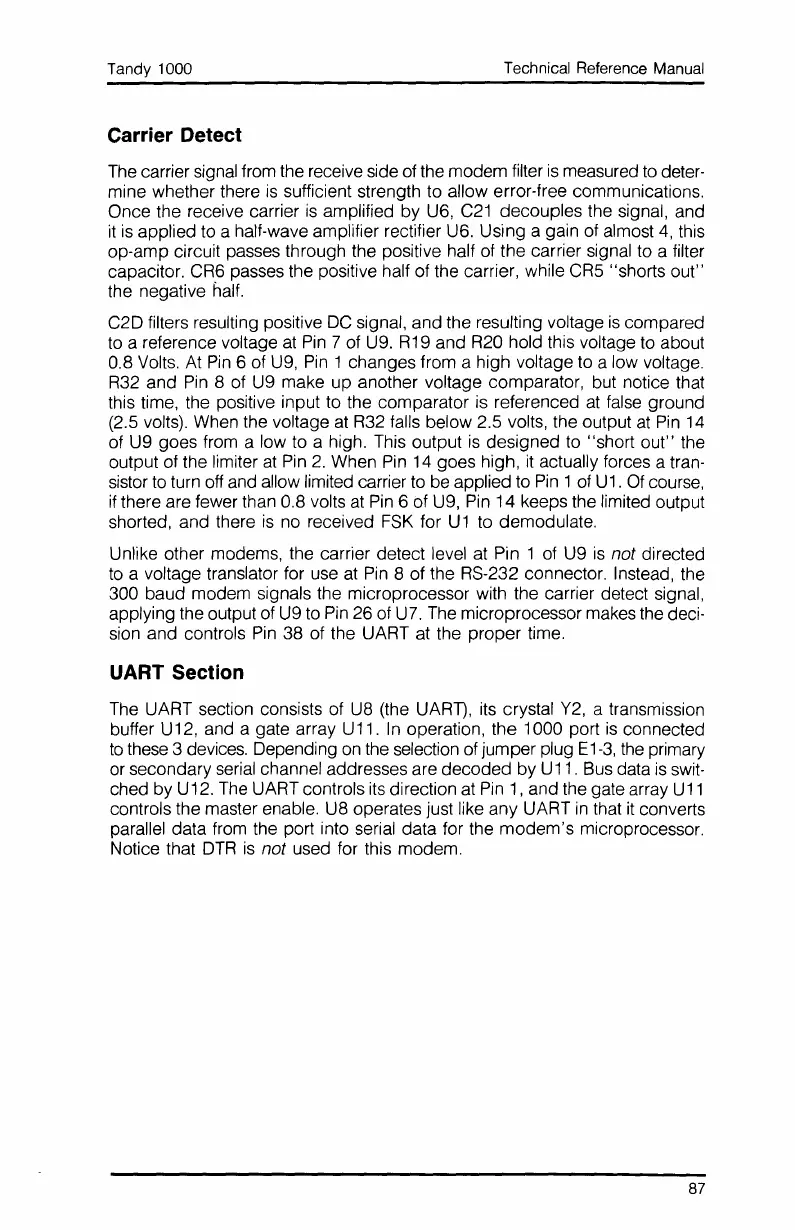Tandy 1000
Carrier Detect
Technical Reference Manual
The carrier signal from the receive side of the modem filter
is
measured to deter-
mine whether there
is
sufficient strength to allow error-free communications.
Once the receive carrier
is
amplified by U6,
C21
decouples the signal, and
it
is
applied to a half-wave amplifier rectifier U6. Using a gain of almost
4,
this
op-amp circuit passes through the positive half of the carrier signal to a filter
capacitor. CR6 passes the positive half of the carrier, while CR5 "shorts out"
the negative half.
C2D filters resulting positive DC signal, and the resulting voltage
is
compared
to a reference voltage at
Pin
7 of U9. R19 and R20 hold this voltage to about
0.8 Volts. At
Pin
6 of U9,
Pin
1 changes from a high voltage to a low voltage.
R32 and
Pin
8 of U9 make up another voltage comparator, but notice that
this time, the positive input to the comparator is referenced
at
false ground
(2.5 volts). When the voltage
at
R32 falls below 2.5 volts, the output
at
Pin
14
of U9 goes from a low to a high. This output
is
designed to "short
out"
the
output of the limiter
at
Pin
2.
When
Pin
14 goes high,
it
actually forces a tran-
sistor to turn off and allow limited carrier to be applied to
Pin
1 of U1.
Of
course,
if
there are fewer than 0.8 volts
at
Pin
6 of U9,
Pin
14 keeps the limited output
shorted, and there
is
no received
FSK
for
U1
to demodulate.
Unlike other modems, the carrier detect level at Pin 1 of U9
is
not
directed
to
a voltage translator for use
at
Pin
8 of the RS-232 connector. Instead, the
300 baud modem signals the microprocessor with the carrier detect signal,
applying the output of U9 to
Pin
26 of U7. The microprocessor makes the deci-
sion and controls
Pin
38 of the UART at the proper time.
UART Section
The UART section consists of U8 (the UART), its crystal
Y2,
a transmission
buffer U12, and a gate array U
11.
In
operation, the 1000 port
is
connected
to
these 3 devices. Depending
on
the selection of jumper plug
E1-3,
the primary
or secondary serial channel addresses are decoded by U11. Bus data
is
swit-
ched by U12. The UART controls its direction at
Pin
1,
and the gate array
U11
controls the master enable. U8 operates just like any UART
in
that
it
converts
parallel data from the port into serial data for the
modem's
microprocessor.
Notice that
DTR
is
not
used for this modem.
87
